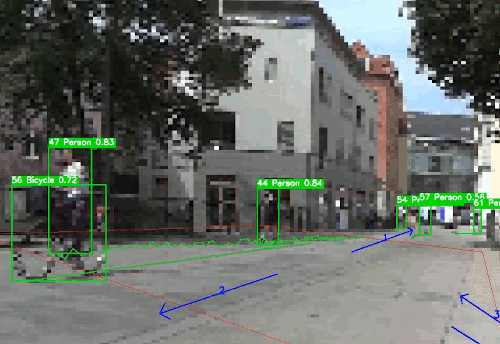With project CityCount we have demonstrated that an AI-based traffic counting of non-motorized traffic participants is feasible in a privacy-aware manner through real-time evaluation directly on the edge device.
Within the BMDV funded research project CityCount, the potential of a low-cost, mobile, easy to install solution is investigated, that can detect and count different classes of traffic participants.
The successful implementation was shown to be feasible for the entire concept. This includes the mobile hardware and camera setup, AI models that achieve real-time data evaluation, postprocessing, storage, visualization, and data provisioning to the user via an analytics dashboard.

The development is based on the real-time evaluation of video data on an edge device using multi-object-detection (MOD), multi-object-tracking (MOT), and a postprocessing step. Several pre-trained MOD and MOT models were tested and deployed on an edge device to investigate their capabilities and limitations. Their performance in real-time video data evaluation varied strongly. Real-time analysis was one of the main challenges within the feasibility study as tracking multiple objects in real-time is a prerequisite for a design that respects data privacy. The video data is processed directly on the device and no personal data is transferred or stored on the server.
Another challenge is the derivation of a count from the extracted MOT tracks which are broken in some parts due to the evaluation algorithm or obstructions of the objects. In a post-processing step, the MOT tracks have to be corrected in order to derive an accurate count. For counting, a region-of-interest (ROI) is defined. The count is based on the movement of objects across the borders of the ROI. The obtained tracks are not only used to derive a traffic count but can also be used to analyze the motion patterns of traffic participant, e.g. turn movement, direction of travel.

Within the project the adaptability and limitations of the device to other applications became apparent. Limiting factors are weather conditions, e.g. rainy weather lead to the detection of boats instead of cars by some algorithms due to the reflective wet surface of the street. Nonetheless, the solution can be adapted to a variety of applications/conditions by the targeted training of the AI model, e.g. new classes of traffic participant, or even counting the number of people traveling in cars.
The project addresses a gap between existing technologies for non-motorized traffic counting and the demand that occurs in city traffic management. Environmental changes, governmental strategies and residents demand for better solutions to increase inner-city non-motorized traffic. Cities are required to improve the infrastructure by setting up more bike paths and pedestrian zones. However, monitoring and counting non-motorized traffic volumes is a challenging task, there are currently no technologies that can monitor several classes of traffic participants, including new classes such as cargo bikes and e-scooters, in an automated manner.
The four associated partners
- City of Düsseldorf, office for traffic management
- City of Erfurt, civil engineering and transport office
- City of Magdeburg, department of urban development, construction and transportation
- City of Köln, office for roads and traffic development
supported the project and provided helpful information about current gaps in technology and requirements regarding use cases and real-world applications.
The project was scheduled for one year and was successfully completed with the final presentation on 16.12.2022 where the results of the feasibility study were presented to project management organization, associated partners, and the public.